Introduction
For well over a century now, my family has been connected with the railways, either as signalmen or as enthusiastic photographers of anything to do with the railways, and now with a son-in-law as an Engineer. It all started back in 1872 when my great grandfather, George Weston, left his position as footman to Lord Sudeley to become a signalman on the Leeds to Skipton railway at Cononley, a little north of Keighley in the West Riding of Yorkshire.
In the usual way of things, in due course George (or rather his wife) had a son, William, who was born in the station house at Cononley. By the time he left school at 14, William wanted to become a schoolmaster but his mother insisted that he start work at the village mill. However, even before the universal introduction of production lines, William was not temperamentally suited to mill work and so he left to become a porter at Keighley station, further enhancing the family ties with the railways. His younger brother Herbert was to become a booking office clerk at Rotherham and Uncle Mark was a signalman on the Great Western at Malvern. What discussions there must have been about the relative merits of Midland and Great Western railways!
An archive of steam railway photographs begins
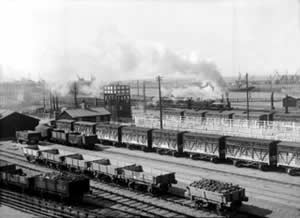
Heysham Harbour at the turn of the 20th century
By the time he reached 18, William had met his future wife Caroline and, with marriage in mind had set about improving his prospects by becoming what was later to be known as a train recorder. When he reached competence, William applied for and got a position at Heysham Harbour box in the Midland Railway's new harbour facility, which opened in 1904. It was here that the collection of photographs was started.
Shortly after his marriage, William bought a half-plate wooden camera of 6d per week 'on the club', and with this he supplemented the family income by taking photographs of the officers of the Midland Railway steamers that operated from the harbour, and of the various personnel and facilities. Because the primary aim was to make a little money, the majority of the photographs are either of people or of scenery in the areas surrounding this and his subsequent postings, but a few of the remaining photographs are of direct railway interest.
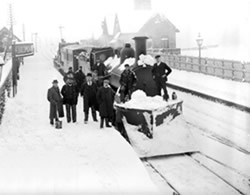
Snow plough at Ribblehead station
on 28th December 1906
1906 saw promotion in the offing and William moved to the Ribblehead box, and it was here that the well-known snow plough photographs were taken. The solitude of Ribblehead proved something of a problem to a young man with two children in need of schooling and so in 1908 a further move was made, to Baildon on the Ilkley branch line. Here the photographs were mainly of the picture postcard type, although a couple of the surviving plates show Baildon at a somewhat less hectic pace that now, and the station somewhat more populated.
In 1915 William and Caroline had a third child, my father, and although in working terms he was to prove to be the break in what had become a family tradition of railway service, the interest in railways blossomed at a very early age and this was combined with an interest in photography gleaned from helping his father make prints for sale around the village as postcards. Starting in the 1930s these two interests were combined and formed the basis of a collection of railway photographs that was still being added to at the time of my father's death in 1979. This despite the fact that he firmly maintained that railways ceased to exist in any interesting form in August 1968, at least as far as the national network was concerned.
Recording the steam trains of Warwickshire
The real heyday of railway photography in the family was in the period 1947 to 1952 when, despite post-war shortages, which included photographic film, hundreds of photographs were exposed at a number of widely separated locations. Having just completed a degree in textiles, a position at Courtaulds in Coventry was to come his way, and this proved to be an almost ideal location as far as railway photography was concerned. Some of my own earliest memories in the latter half of this period include standing by one of those stunted telegraph poles on the embankment overlooking Rugby No. 1 box, passing the darkslides to my father as train after train passed by, while I am told that the early part of the period was punctuated by the rattle of conkers gathered near Catesby tunnel and placed in a treacle tin in my pram.
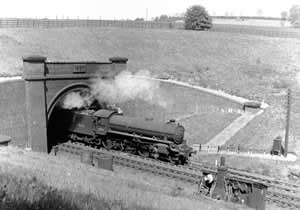
No. 61141 steams out of Catesby Tunnel
on May 14 1949
Yes, Coventry was ideally situated for a railway photographer. On the main line itself, with its web of cross-country and main lines, Birmingham and Saltley were about the same distance. Then there was the peace and tranquility of Catesby on the Great Central - appreciated by Mums and baby daughters for the peace of the countryside, by small boys for the wonderful conkers, and then there were the trains too. Looking back at this era though, it does seem as though there was a choice of either B1s or one or other form of 04 and not much else.
A perhaps less obvious but still pleasant location was Hatton, just north of Warwick and Leamington Spa. Here was the Great Western with its splendid green engines in the heart of the Warwickshire. That gave two regions within about 20 miles of home, and both main lines to boot. But the remaining two regions were not to be forgotten.
Southern summers and the eastern region
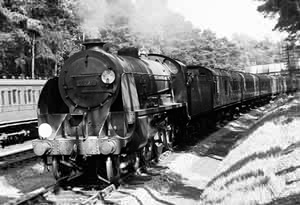
No. 30779 passing Meyrick Park on 10th June 1949
When my father was very young and living in Cononley, his father (William) used to take advantage of the privilege tickets available to staff and of the arrangement with the Somerset and Dorset Joint Railway, to send his family on holiday to Bournemouth for a fortnight while he followed later for the second week. This holiday in Bournemouth was to continue annually long after my father had left home and started his own family. So each June we would trek off to Bournemouth - and railway photographs for my father while the rest of us relaxed on the beach. After a carefully chosen two or three hours at Parkstone, Meyrick Park, or Branksome, there would be more southern steam in the bag and back he would come to rejoin his family.

No. 67372 outside Leeds Central Station
on 20th June 1950
In just the same way, the eastern region was covered during trips from Coventry back up to Cononley. Here either Leeds Central Station or Bramhope were the favourite locations, although the chance to photograph the workings around Skipton was not missed. By this means, all English regions were covered in a reasonably thorough manner, limited mainly by lack of film.
After the steam age
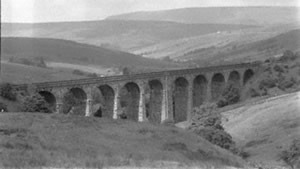
Dent Head Viaduct in the 1960s
The ensuing years saw trains take more of a back seat as the numbers of diesel locomotives grew and interest switched to the architecture and environs of the railway era. As far as photographs were concerned, these were still exposed in even larger numbers than before as both film and time were now available, but the subjects tended to be viaducts and bridges rather than descending to pictures of diesels, which held no interest whatsoever.
